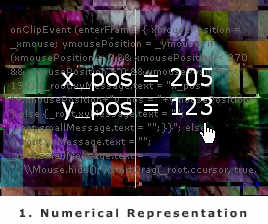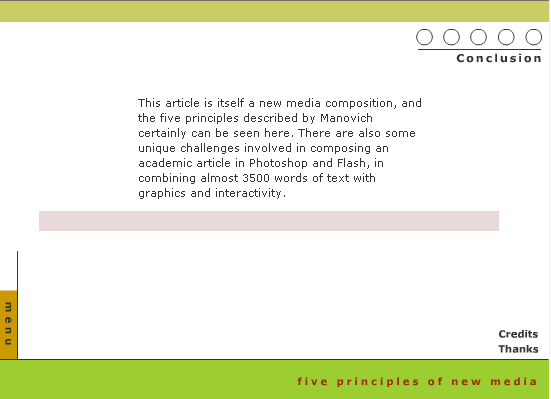Discovering Digital Dimensions at C&W 2003
David Blakesley
continued . . .
Playing with New Media
Madeleine Sorapure's "Five Principles of New Media: Or, Playing Lev Manovich" is a tour de force example of how multimedia can function pedagogically. Her Flash article teaches as it delights. It demonstrates some principles that we should bear in mind not just when we compose "lessons" in new media, but probably that we should bear in mind whenever we aim to teach the generative principles of reading and writing. You can discern in her title one principle at work: be focused. It's often the case that we try to do too much with our pedagogy and lose that focus, which can be especially dangerous when teaching and producing multimedia writing. There are always many things one can say, but when you add to that the wide range of presentational modes--from paper to overhead transparencies to Flash movies--and the digital tools to create them, teachers and students can be overwhelmed quickly. Many experienced Web designers, for instance use a wide variety of software technologies when they practice their craft, but I believe it's a mistake to lay them all out on the desktop at the start. It's very helpful to focus on delivery and production, which can help those more inexperienced realize the advantages of any particular interface. What we find, also, is that with such focus comes deeper insight and, as an unexpected bonus, potentially even greater complexity.
Sorapure draws our attention to five principles of
new media as articulated by Lev Manovich in his influential The Language
of New Media (2001). There are many more principles of new media
than those five, of course, but Sorapure wisely focuses on the five most
important. Her Flash article teaches those principles verbally and visually,
even interactively.  When
we read a definition of "numerical representation," for example, we
see numerical representation at work as
the mouse moves over the image (showing Javascript superimposed on a
watchful eye). But we also get to see student examples of their interpretations
and illustrations of these principles in other contexts. So you have,
in a compact and elegant package, the principles themselves defined and
illustrated, as well as the work of the students, featured as it is right
alongside the work of the teacher. Rarely even in the best articles
on the teaching of writing do we find such a seamless integration of
instruction, elaboration, and demonstration. I believe that multimedia
authoring encourages this kind of integration and that for teachers and
students, it will have lasting benefits.
When
we read a definition of "numerical representation," for example, we
see numerical representation at work as
the mouse moves over the image (showing Javascript superimposed on a
watchful eye). But we also get to see student examples of their interpretations
and illustrations of these principles in other contexts. So you have,
in a compact and elegant package, the principles themselves defined and
illustrated, as well as the work of the students, featured as it is right
alongside the work of the teacher. Rarely even in the best articles
on the teaching of writing do we find such a seamless integration of
instruction, elaboration, and demonstration. I believe that multimedia
authoring encourages this kind of integration and that for teachers and
students, it will have lasting benefits.
Benefits aside, Sorapure's Flash article represents hours of work and (clearly) draws on substantial experience in composing in Flash, not the easiest of programs to learn. Although it doesn't seem on the surface to contain so much, the article consists of some 3,500 words alone, just a bit shorter than the length of a typical article in a journal like CCC. There are many images, too, and embedded in the Flash move, Action Script and other code that makes the reading interactive and (interestingly) a demonstration itself of the principles it discusses.

Unique challenges indeed. Challenges that we need to confront sooner rather than later and that I fear we're not quite ready for, despite having about ten years time to learn to design for the Web and even more than that to write hypertext that fulfills its promise.